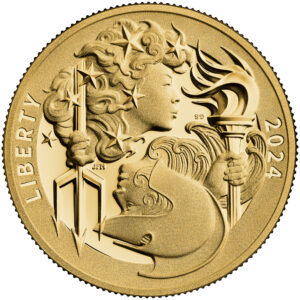By Stephanie Meredith
February 8, 2024
Watch Chief Engravers Joe Menna (U.S. Mint) and Gordon Summers (The Royal Mint) talk about their work on this groundbreaking collaborative design for the 2024 Liberty & Britannia Program.
“I wanted people to be able to see themselves in this Liberty. I wanted her to represent all Americans.” – Joe Menna, U.S. Mint Chief Engraver
Today, two of the world’s largest mints make history with the release of the Liberty and Britannia Program. The U.S. Mint and The Royal Mint partnered to create a collaborative design, pairing the figures of Liberty and Britannia on a coin for the first time. The chief engravers of each mint created a harmonious and balanced design celebrating both nation’s symbols, which have been used on coins for hundreds of years.
This is a first of its kind partnership for the two mints. In the past, the U.S. Mint and other world mints paired coins to create sets, such as the 2019 Pride of Two Nations released with the Royal Canadian Mint.
In 2020, the U.S. Mint and The Royal Mint collaborated on a gold coin set and a silver coin and medal set with a shared theme. The sets honored the 400th anniversary of the Mayflower voyage. A single artist, Artistic Infusion Program designer Chris Costello, created all the Mayflower designs for the products. After that successful partnership, the two mints looked for new ways to collaborate.
Obverse Design

U.S. Mint Chief Engraver Joe Menna and The Royal Mint Chief Engraver Gordon Summers paired the allegorical figures of Liberty and Britannia to celebrate the relationship between the United States and the United Kingdom. To Americans, Liberty embodies the defining principle of the nation. She has appeared on U.S. coins throughout history. The figure of Britannia is the personification of Britain and has appeared on British coins since the 1600s.
The chief engravers depict the two portraits in profile, resembling faces on a playing card. One is right side up while the other is upside down – until it’s rotated. “Coins are art that you hold in your hand. This one not only demands that you hold it in your hand, but to fully enjoy it, you need to rotate it,” explains Joe.
The symbols identify each figure. Liberty carries a torch and is adorned with stars. Joe says of Liberty, “Her hair is wild, and the stars are freely floating around her head.” Her features reflect the many different ethnicities that make up America so that everyone can see themselves in her image. The torch represents enlightenment and was a symbol used in historic designs such as Augustus Saint-Gaudens’ 1907 $20 gold coin.
Britannia wields a trident and wears a Corinthian helmet. The Corinthian helmet represents her origins as a figure on Roman coins. The Romans often depicted the province of Britannia as a woman. The trident reflects Britain’s maritime power in the 17th and 18th centuries when she first made her appearance on British coins.
To create this design, Joe and Gordon thought about what Liberty and Britannia meant to them. Then they traded drawings back and forth to envision a complementary treatment of both figures.
With the help of stakeholders from both mints, the ideas were narrowed down for the chief engravers to develop further. Committees in both countries reviewed the two final designs choices: Liberty and Britannia portraits arranged like a playing card or full figures standing next to each other. They chose the playing card option to recommend for final approval by the Secretary of the Treasury in the U.S. and King Charles III in the U.K.
The U.S. Mint will use this design on the obverse of a gold coin and a silver medal paired with a reverse design by Joe. The Royal Mint will use the design as the reverse on a variety of gold and silver coins with the king on the obverse.
Reverse Design
Chief Engraver Joe Menna designed the reverse of the Liberty and Britannia gold coin and silver medal. The design shows the sun rising over the Atlantic Ocean. It is framed by two shores with a bristlecone pine tree in the west and an English yew tree in the east, representing both nations.

“The reverse is the idea of the two oldest trees on each continent reaching out across the sea to each other,” says Joe. The symbol of the bristlecone pine is taken from the 2023 American Liberty Gold Coin designed by Elana Hagler and sculpted by Joe. The sun references historic coin designs such as Adolph A. Weinman’s 1916 Walking Liberty half dollar. The water is very active, reminiscent of the Japanese prints that inspired Joe.
Speaking of the artistic freedom he felt during this project, Joe reflects, “The reverse of this coin is the first good coin design I feel I’ve ever done. I realized I had been designing coins the way I thought they should be designed instead of how I wanted to design them.”
See more Inside the Mint articles.


